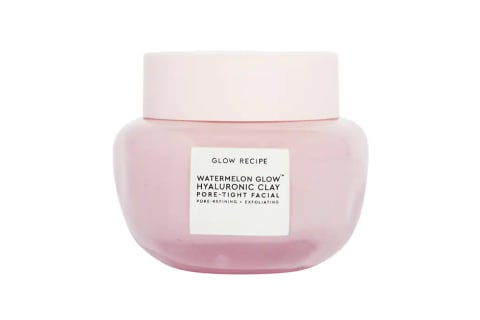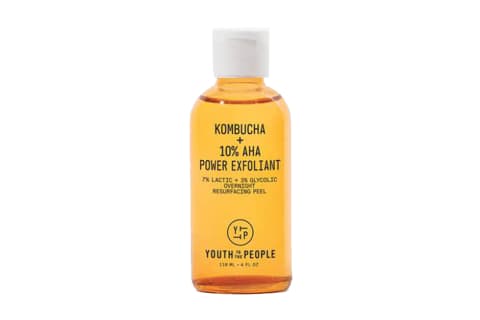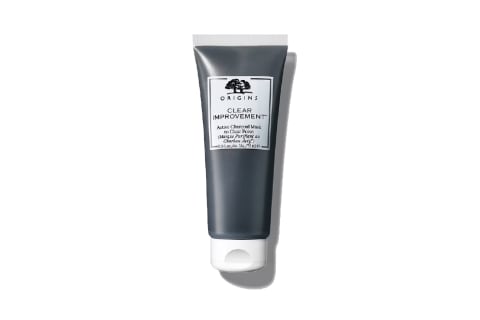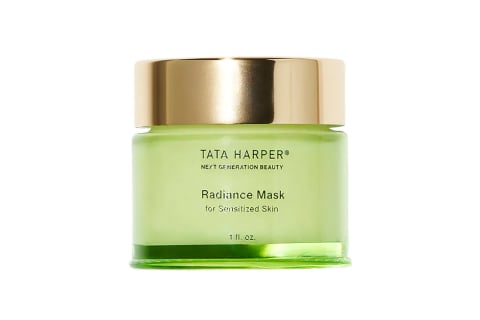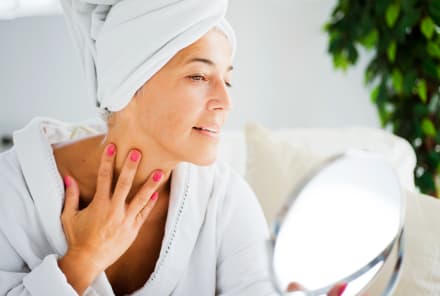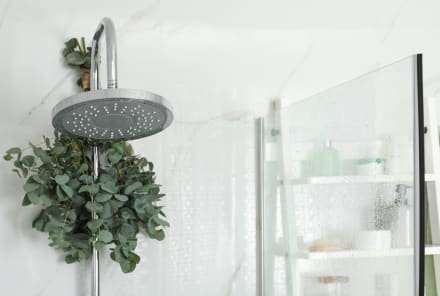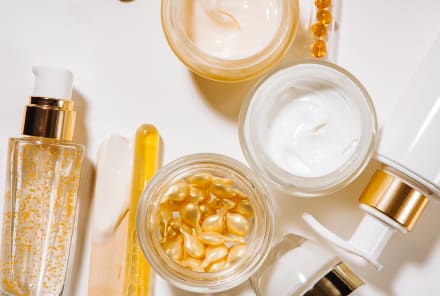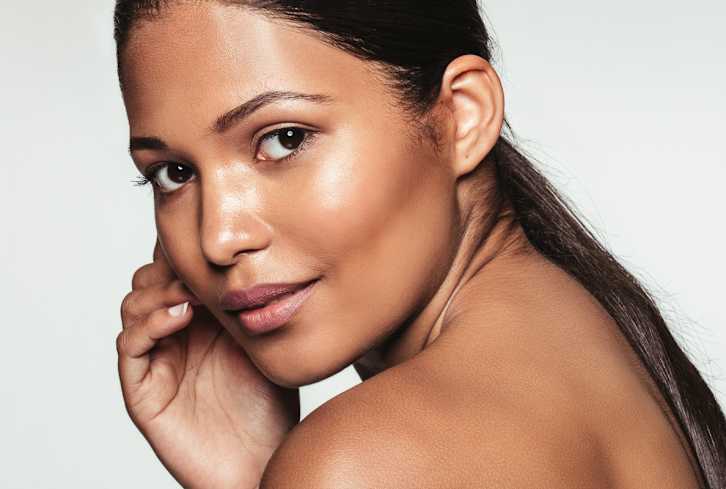Advertisement
Are You Hyperfixating On Your Skin? Here's What Derms Want You To Know About Clogged Pores


Repeat after me: Not all pores are clogged pores. While it's easy to look at your skin in a close-up mirror and assume all of your pores are clogged just because they're visible, that's not totally the case.
In an airbrushed world, we're made to believe that just because you can see small dots on your face they must be clogged, no? Well, no.
That being said, some folks are more prone to blackheads than others. And clearing out clogged pores before they turn into full-fledged breakouts is one of the best ways to manage acne.
There are more than a few ways to do this, so we're going to break down the most effective options below. Let's dive in.
What are clogged pores?
Clogged pores start with oil buildup on the skin. This oil that you naturally produce is called sebum. Regulated sebum production is actually beneficial, as it keeps the skin moisturized. However, excess sebum is what leads to clogged pores, aka sebum plugs.
Because sebum is a sticky consistency, it easily clings to dirt and bacteria as well. When this clog is exposed to oxygen, it takes on a darker color—which is what makes blackheads different from non-exposed clogged pores.
Clogged pores can sit flat on the skin or become raised, depending on how clogged they are. These clogs may turn into larger pimples such as pustules or papules—you can read more about those here.
Summary
Pores—even visible pores—are normal
Even the supermodels behind the airbrushed images do, in fact, have pores. The perfectionism in advertisements has contributed to the toxic narrative that having no visible pores at all is the goal, but that's simply impossible.
So before you try to use every exfoliating serum and extracting tool on the market in an effort to try to shrink your pores down to none, remember that they're completely normal. What's more, you're probably just hyperfixating on your skin.
Sitting in front of a magnified mirror for an hour trying to figure out how you can eliminate the look of real skin and achieve a flawless complexion isn't going to help you achieve something impossible. Not to mention, it's not good for your mental health.
And if you're getting wound up over whether or not your pores are clogged and how to fix it ASAP, remember that stress is one thing that actually can lead to breakouts—so take a deep breath for the sake of sanity and your skin.
How to get rid of clogged pores
Now that we've established the normality of having pores, let's go through a few best practices for managing clogged pores. It's worth noting that one method missing from this list is squeezing your pores—because it's not a best practice.
"You shouldn't squeeze clogged pores, as often this can lead to more inflammation, scarring, and risk of infection," board-certified dermatologist Marisa Garshick, M.D., FAAD, tells mbg. So before you get out your tools, remember that the chances of your clogged pores getting worse are higher than the chance of a quick squeeze doing any good.
Instead, opt for one of the following methods:
BHAs
Beta-hydroxy acids, also known as BHAs, are going to be your best bet when it comes to treating clogged pores. "Because BHAs are oil-soluble, they can penetrate deep into the pores and therefore are especially helpful at unclogging the pores and reducing excess oil," Garshick explains.
But they're not just good for post-clog treatment. BHAs are classified as chemical exfoliants, meaning they help to slough off dead skin cells and, in turn, prevent clogged pores simultaneously.
Summary
AHAs
Alpha-hydroxy acids, or AHAs, are more of a preventive measure and help improve overall skin appearance. "AHAs, like glycolic or lactic acid, work to get rid of dead skin cells, which prevents the pores from becoming clogged," Garshick notes.
Not sure how to remember which acid does what? "You can think of it this way: AHAs work above (A for AHA and Above) the surface of the skin, whereas BHAs work below it (B for BHA and Below)," medical esthetician and founder of JTAV Clinical Skincare Joie Tavernise explains.
You don't have to choose one or the other. In fact, using an exfoliating serum with a combination of the two acids is the most efficient way to keep the pores clear and maintain a smooth, dewy complexion at the same time.
Caveat: However, be sure not to mix two separate serums together. Look for a pre-formulated combination serum instead.
Summary
Clay or charcoal masks
"Clay and charcoal masks work by drawing out buildup such as debris and oil from pores," board-certified dermatologist Ramya Garlapati, M.D., tells mbg. This is why clay masks are often viewed as a deep cleanse for the skin.
However, these masks aren't for everyone. "They can be very drying, so it's best to limit using them to a few times per week, and they should also be used in caution in those with dry skin types," Garlapti adds.
If you're going to use raw clay powder, be sure to mix it with a hydrating, noncomedogenic oil like jojoba, rosehip, or grapeseed oil to prevent drying out the skin. And if you have dry or sensitive skin to begin with, opt for other remedies altogether.
Summary
Retinol
While retinol is famous for healthy skin aging, it's incredibly beneficial for preventing clogged pores, too. "Retinol helps to improve skin cell turnover and clear away excess sebum, dead skin cells, dirt, and bacteria," board-certified dermatologist Rebecca Marcus, M.D., FAAD, explains.
What's more, "It also helps to normalize the sebaceous gland and regulate its secretions," Marcus says. So if your skin is on the oilier side, using a retinol serum or cream can help to regulate your oil production over time and prevent buildup.
Even when it comes to pore size, retinol can help make the pores appear smaller (though larger pores aren't anything to worry about).
Garlapti explains, "[Retinol] decreases inflammation and increases collagen production, which helps to strengthen the walls of pores, making them appear smaller over time."
Summary
Get an acne facial
Now let's talk about extractions. While you shouldn't take an extraction tool to your own skin DIY-style, it can be done by a professional. While you do know your skin better than anyone else, skin experts have proper tools, sanitation practices, and training to perform extractions in a safe and effective manner, which is why it's not as safe to do at home.
So if you're dealing with clogged pores more often than not, you may consider an acne facial. Beyond just extractions, acne facials also include topical treatments with ingredients like salicylic acid, benzoyl peroxide, tea tree oil, etc.
Acne facials may even include a blue light therapy session, which can help to kill bacteria, regulate sebum production, and soothe the skin. You can read all about these facials here if you want to learn more.
Summary
Scrubs or physical exfoliators
Physical exfoliators like gentle scrubs can help to manually slough off dead skin cells, thus reducing the chance of getting a clogged pore. Plus, they offer instant positive results for your complexion.
"Physical exfoliation offers instant gratification, as dead skin cells and dirt are swept away during the treatment," board-certified dermatologist Jessie Cheung, M.D., founder of Cheung Aesthetics and Wellness previously told mbg.
If you're going to take this route, look for gentle exfoliants with fine, sugarlike granules rather than harsh salt scrubs or those with large beads made from nut shells or plastic. This will help prevent over-exfoliation, irritation, and redness.
Summary
Enzyme masks or cleansers
For those with sensitive skin that cannot tolerate any of the above, enzyme masks or cleansers may be a better option to clear the pores.
"Enzymes can exfoliate and help to get rid of dead skin cells and in doing so, can help to improve the appearance of clogged pores and congestion of the skin," Garshick explains.
What's more, "They can also act as a keratolytic, breaking down keratin and helping clear away dead skin cells from the surface of the skin," Marcus explains.
Summary
Hydrocolloid patches
Hydrocolloid patches create a protective seal over the skin while absorbing excess fluid like sebum. "Hydrocolloid patches, particularly those that contain salicylic acid, may be helpful to address clogged pores," Garshick notes.
While these patches may be beneficial to temporarily improve the appearance of the pores, they don't necessarily prevent new breakouts from forming, Garshick adds.
Hydrocolloid patches are certainly a better choice than typical black strips as the latter can damage your skin barrier—more on that to come.
Summary
Visit a derm
Say you've tried all of the above and still struggle with clogged pores—it might be time to see an expert. "If you are trying over-the-counter products without improvement, experiencing dryness or sensitivity to products and having trouble finding the right products, or if any of your breakouts are leading to scarring, it can be helpful to see a dermatologist," Garshick explains.
Dermatologists and licensed estheticians can offer extractions, chemical peels, and prescription-grade products, all of which can be helpful for chronically clogged pores. Plus, these experts can help you put together an A+ routine for keeping your skin clear after in-office treatments.
Prevention tips
Once you've put in the work to get your pores clear, you'll want to work on maintaining that status quo. To keep up the good work, keep the following in mind:
- Avoid comedogenic moisturizers: As most dermatologists will suggest, check your topical products for comedogenic ingredients (read: ingredients that may clog your pores). You can do this by running the full ingredient list (which can be found online) through a pore-clogging ingredients checker like this one from Acne Clinic NYC.
- Wash your face nightly: To minimize oil and dirt buildup on the skin, you should be washing your face every night. If you want to cleanse in the morning, feel free to add that step, too. If you wear makeup or sunscreen, consider double-cleansing with oil in the evening to remove the products before you go in with a water-based cleanser.
- Address lifestyle factors: Skin care is much more than just what you put on your face. Be sure to get a full night's rest as often as you can, minimize stress, and do your best to eat as many whole and natural foods as possible and drink enough water.
Are pore strips good for clogged pores?
Traditional, sticky black strips are not the same as hydrocolloid patches and may actually make the problem worse. "Hydrocolloid patches tend to be gentler than blackhead strips, whose adhesive can be damaging and disruptive to the skin barrier," Marcus explains.
When the skin barrier is compromised, your skin is more susceptible to bacteria and your oil production will be thrown off. Stick with the options above and skip the abrasive blackhead strips. Or make your own pore strips at home—here's how.
FAQ
Do clogged pores ever go away?
Clogged pores can be cleared using exfoliants like BHAs, retinol, extractions, and prescription-grade products. However, your actual pores will not go away. Again, seeing your pores in the mirror is completely normal and it's best to avoid hyperfixating on your pores for the sake of your mental health and your skin.
Is it OK to squeeze clogged pores?
"You shouldn't squeeze clogged pores as often this can lead to more inflammation, scarring, and risk of infection," board-certified dermatologist Marisa Garshick, M.D., FAAD, tells mbg. Instead, opt for physical exfoliants, retinol, or professional extractions, or see a dermatologist.
Can you get rid of clogged pores overnight?
The quickest way to get rid of clogged pores is by seeing a licensed esthetician or dermatologist for extractions, using a hydrocolloid patch, and exfoliating the skin.
Best products to get rid of clogged pores
The takeaway
The good news is that there are plenty of ways to clear clogged pores. Rather than using sticky blackhead strips, stick to regular exfoliation with BHAs and AHAs, incorporate a clay mask into your routine once a week, and visit a dermatologist or esthetician if you can. If your clogged pores are consistently turning into larger breakouts, you may actually be dealing with another form of acne. If you need help navigating the vast world of breakouts, check out this guide. And remember—not all pores are clogged pores, so give yourself some grace next time you look in the mirror.
-v1646695196476.jpg?1148x800)
